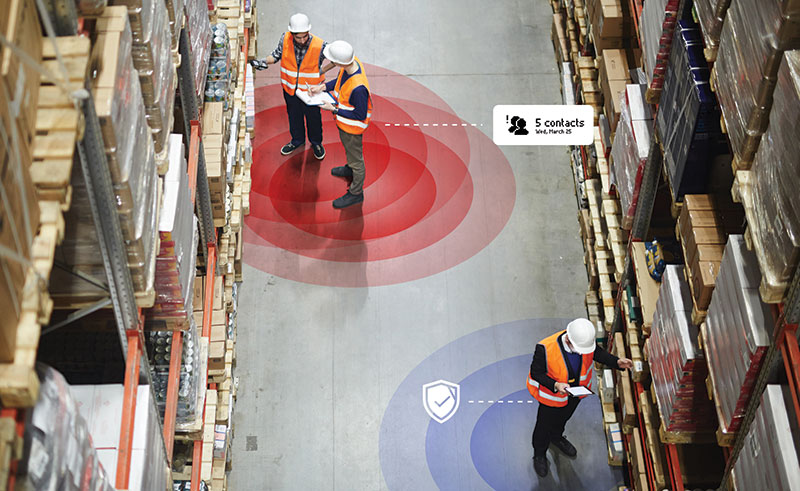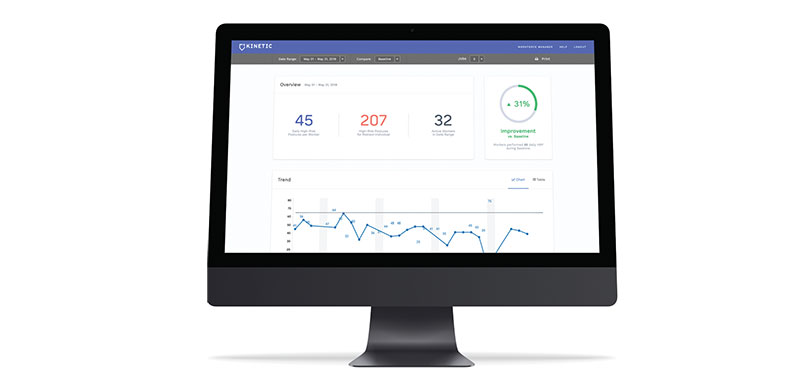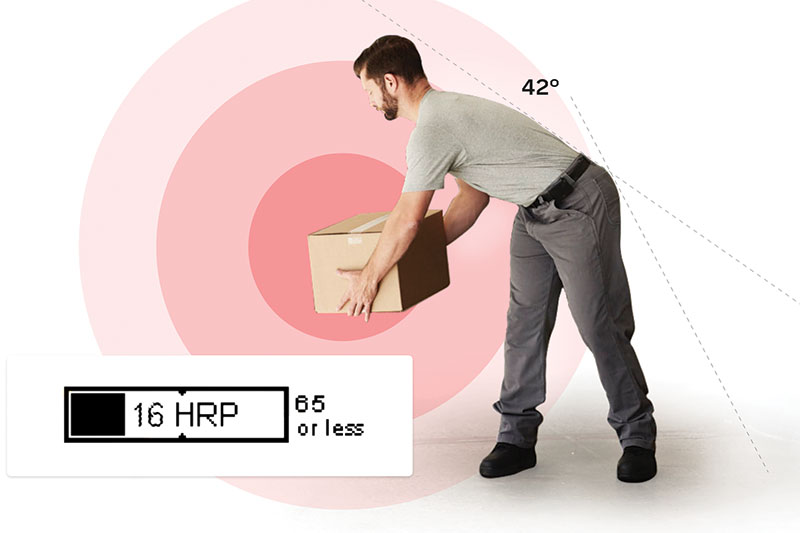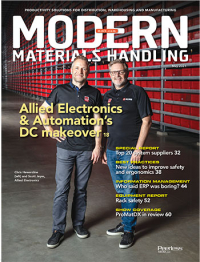New ideas to improve safety and ergonomics
Better body mechanics. Less potential Covid exposure. Improved picking performance. Fewer injuries. Those are four of the benefits that wearables and warehouse software are bringing to people out on the DC floor.
Most every story about safety and ergonomics in the warehouse features equipment such as lift tables and rack netting. This isn’t that story.
Instead we went in another direction. This one focuses on wearables and software. Not that lift tables and netting aren’t still essential. They very much are. However, with some digging around we discovered some possibly overlooked options you have for making strides in safety and ergonomics.
Let’s face it: We’re in a different spot right now than we were 18 months ago. E-commerce demand remains especially strong following at least a 40% surge in the past year. Meanwhile, traditional retail replenishment demand continues to build as people return to the stores.
That translates into constant pressure in the warehouse and distribution center to maintain high throughput and productivity levels to meet strong demand. But you can’t push people too far, ask them to move too fast or perform awkward, even harmful motions. There will be consequences, and none of them are good.
At the same time, some degree of social distancing is required in any DC, creating its own set of pressure points and bottlenecks. That often requires workarounds, not all of them as efficient. Yet, demand is not relaxing one bit.
That said, perhaps Victoria Brown, product manager at Körber, put it best: “If you don’t have a safe facility, you won’t have a business.” And with all that’s going on these days, it’s time for some new ideas for help on the safety and ergonomics front. We can all use the help.

Social distancing on the DC floor can be tracked using a wearable device that identifies close contacts throughout the day.
Setting a baseline
As it turns out, wearables and software are not exactly new here.
On the data collection front, wearable terminals and ring scanners have been with us for some time. So have voice systems. All continue to make their contributions to maximizing data capture efficiency with the least ergonomic impact.
But the wearables we’re talking about here are quite different. More on that in a minute.
Similarly, labor management software (LMS) has always been about tracking and monitoring worker activities and productivity, points out Dan Gilmore, chief marketing officer at Softeon. For instance, LMS is tied into the Golden Zone of picking to better match the slotting of items to the pick frequency and demands on worker’s motions, maximizing beneficial ergonomics.
At its best, labor management is a data-driven tool, adds Gilmore. It interfaces with the warehouse management system (WMS) to best match tasks to individuals and their skills. Ideally, LMS identifies who is best suited to a task and assigns that person to it and others like it.
While not as radical as the change in wearables here, LMS seems poised to take on new safety and ergonomics tasks in the warehouse.
New age wearables
Probably the most out-of-the-box development here is the Reflex wearable device.
“The idea is to improve body mechanics on the job,” explains Haytham Elhawary, founder and CEO of Kinetic.
Worn on a belt and about the weight of a pack of cards, the device is packed with sensors that identify and track movements of the individual. The data is sent by Wi-Fi to a Cloud-based server for analysis later by safety professionals able to customize their insights to individual workers.
Kinetic already has broad real-world input from the wearables, says Elhawary. It’s currently used by more than 50 companies, primarily larger enterprises such as Iron Mountain and Pepsi. More than 10 million hours of data from tens of thousands of workers have been collected and analyzed.
They have learned that the average warehouse worker assumes 103 high-risk postures daily. By working with people, safety professionals have been able to improve the ergonomics of their motions quite noticeably. Where Reflex has been used, Elhawary says injury frequency dropped 50% to 60%, while lost work days fell 80%.
What’s especially interesting here is that none of these gains are the result of workplace redesign. All are the direct result of improving the body mechanics of workers.
Over at Softeon, the focus is on a wearable device that tracks the location of individuals in the warehouse, says Gilmore. He calls it socially distanced risk management.
The intent is to ensure people remain 6 feet distant from others at all times. The device, which connects to a central server with a radio beacon, follows workers throughout the day, identifying the incidents when they are closer than 6 feet to others for contact tracing efforts (see graphic).
But that’s not all the wearable does, says Gilmore. It’s also tied into the WMS and LMS, which direct routing of people to ensure they remain 6 feet apart. The software minimizes the hit on productivity despite the rerouting. And it’s all invisible to the worker.
“Socially distanced task management is all about keeping workers safe while maximizing their routing and productivity,” Gilmore adds.
A similar approach is MotionWorks Proximity from Zebra, explains John Wirthlin, industry principal for manufacturing, transportation and logistics. The platform allows a DC to manage contact tracing and help employees reduce risk of exposure to the virus. It also reminds employees of the importance of maintaining social distance.

A data dashboard aggregates each person’s movements and body motions during the day, identifying opportunities for more ergonomic actions.
As Wirthlin explains, a Bluetooth tag on an individual’s badge identifies when the person is closer than 6 feet to others and the length of those events. The tag communicates with the MotionWorks Warehouse middleware that provides complete visibility of people and assets across the warehouse operation. Beyond keeping workers safe on the floor, the MotionWorks suite improves asset tracking and visibility in these times of high volume and strong consumer demand.
It’s also worth noting, says Wirthlin, that MotionWorks Proximity won the 2020 IoT Breakthrough innovation award for enterprise solution of the year.
LMS driving behaviors
“A key concept behind LMS is not working faster,” says Peter Schnorbach, senior director of product management at Manhattan Associates. “Instead, LMS is about working at a safe and appropriate pace that results in accuracy of picks and task completion. It’s about driving positive, appropriate behaviors,” he adds.
And never has that been more important.
There is a battle at every warehouse and DC to find and retain people. Schnorbach, and others, point out that was true before Covid and hasn’t changed. He goes so far as to call it “a radical labor situation.” Who would disagree?
“We need to better engage the workforce. And labor management gives us a chance to do that,” Schnorbach adds. “We need to better engage each individual, make them feel valued and part of what’s going on. Companies will have to work really, really hard to better appeal to people out on the floor. We have to move away from the traditional ‘stick and carrot’ approach,” he says.
Part of that appeal is helping them do their jobs better.
Raj Patel, senior director of supply chain strategy at Blue Yonder breaks that process down into four steps: monitoring people, training them, reporting their progress and preventing injuries.
He notes this is a two-way street in which the LMS not only collects information, but returns it to people in a positive way that better matches them to their tasks. And it can go even further, says Patel.
In fact, it can help people to better manage their own shifts and team up with others to get the job done. It offers increased transparency and autonomy to people as they work to meet metrics and missions.
Engineered standards, says Brown of Körber, is part of the solution here, helping people perform repetitive work safely without focusing on who is the fastest. “People shouldn’t feel they are being pushed too fast. They need help to use their body in a more productive manner,” she adds.
Patel goes so far as to predict that ergonomics will be the “next big data project in the warehouse.” He expects that in the next three to six months, there will be increasing attention paid by LMS suppliers to track and match product placement and the movement of people to improve the body mechanics of everyone.
“Covid has brought to the forefront the need for safety in the warehouse. We are clearly on a path to collect data, synthesize it and use it to prevent injuries,” Patel adds.
Now you’ve just read several experts say that speed is not the goal. But that doesn’t mean there is no competition among workers and teams out on the warehouse floor. Au contraire. Competition is alive and manifests itself as gamification these days.
While many think of gamification as a hotspot for Millennials, it’s a very real attraction for people of all ages. And, in fact, gamification came across from the experts interviewed here as a common theme that strongly engages people to rely on wearables and LMS for safety and ergonomic input about their jobs.
In fact, they don’t mind in the least having performance metrics posted on a giant leader board for everyone to see. They don’t mind looking at a terminal that ranks team members’ performance. And to Schnorbach, that all makes sense.
“Gamification offers a gauge of doing a job well, including a mastery of it in comparison to others. It also provides transparency as to how each team member is doing. And perhaps most importantly, gamification provides autonomy because people realize they’re responsible for their own actions. It’s all part of the self-determination theory that’s behind gamification in the first place,” says Schnorbach.
As Brown says, “the emphasis now is to set a tone of safety and trust. When that is in place and people understand realize it, they will rise to the occasion.” Sounds like wearables and LMS are part of the new trajectory for safety and ergonomics in the warehouse.

Article Topics
Ergonomics News & Resources
Advance Lifts marks 50th anniversary Shift Robotics demonstrates warehouse Moonwalkers HeroWear demonstrates a back-assist exosuit SIGI announces key leadership promotions Autoquip Corporation acquires German company J.A. Becker & Söhne Monorail Manufacturers Association celebrates 90 years of monorail best practices Caster Concepts expands manufacturing facility in Albion, Mich. More ErgonomicsLatest in Materials Handling
Beckhoff USA opens new office in Austin, Texas Manhattan Associates selects TeamViewer as partner for warehouse vision picking ASME Foundation wins grant for technical workforce development The (Not So) Secret Weapons: How Key Cabinets and Asset Management Lockers Are Changing Supply Chain Operations MODEX C-Suite Interview with Harold Vanasse: The perfect blend of automation and sustainability Consultant and industry leader John M. Hill passes on at age 86 Registration open for Pack Expo International 2024 More Materials HandlingAbout the Author
Subscribe to Materials Handling Magazine

Find out what the world's most innovative companies are doing to improve productivity in their plants and distribution centers.
Start your FREE subscription today.
April 2024 Modern Materials Handling

Latest Resources












